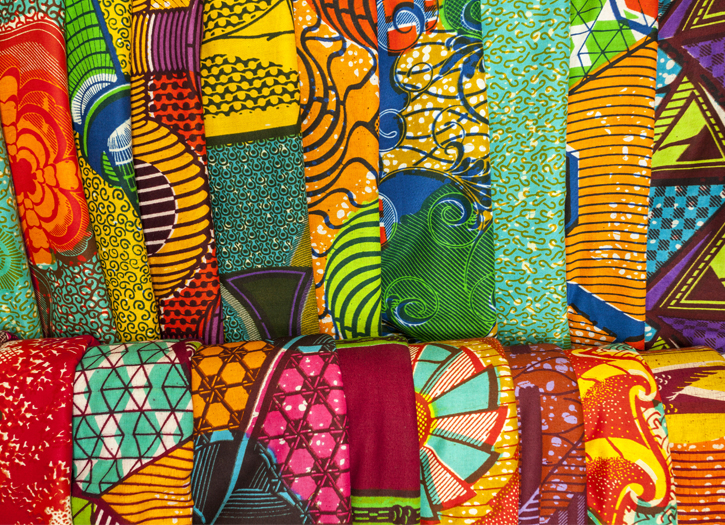African textiles are textiles from various locations across the African continent. Across Africa, there are many distinctive styles, techniques, dyeing methods, and decorative and functional purposes.
Stripweaving, a centuries-old textile manufacturing technique of creating cloth by weaving strips together, is characteristic of weaving in West Africa, who credit Mande weavers and in particular the Tellem people as the first to master the art of weaving complex weft patterns into strips. Findings from caves at Bandiagara Escarpment in Mali propose its use from as far back as the 11th century. Stripwoven cloths are made up of narrow strips that are cut into desired lengths and sewn together. From Mali, the technique spread across West Africa to Ivory Coast, Ghana, and Nigeria. Raphia fiber from dried stripped leaves of raphia palm was commonly used in West Africa and Central Africa since it is widely available in countries with grasslands like Cameroon, Ghana, and Nigeria.
Asante Kente:The Asante were the dominant people of West Africa’s Gold Coast, present-day Ghana. Controlling the only source of gold available, the Asante traded with other African states and later with Europeans after contact with the Portuguese in the 15th century. With their wealth and a rich source of gold, they made all forms of jewelry, amulets, and talismans from the gold. In the 18th century, the Asante acquired knowledge of the strip weaving technique through trade that is seen in the present-day Ivory Coast.Ewe Kente: Kente cloth is also worn by the Ewe, who were under the rule of the Asante kingdom in the late 18th century and now located in Ghana and Togo. The Ewe, who had a tradition of horizontal loom weaving, adopted the double heddle frame loom style of kente cloth weaving from the Asante with some important differences.
Nigerian Aso Oke: Aso oke meaning top cloth, is the most prestigious hand-woven cloth of the Yoruba of Nigeria due to the level of expertise and time required to weave the cloth. Traditional indigo-colored Aso oke often required the hand-spun thread to be dyed up to fourteen times to achieve the deep blues needed. Special techniques were used to make the threads colorfast so that they would not damage the lighter colored threads or embroidery when washed. The raw silk Aso oke called sanyan requires thousands of moth cocoons to be collected and their silk carefully unraveled and spun into thread. These types of labor-intensive activities were prerequisites to weaving and hand embroidering.
Ethiopian Cotton: With the exception of Ethiopia, textile weaving is less common in East Africa. In the 1st century, cotton was imported into Ethiopia by Arabs. Ethiopia has conditions that are good for growing cotton thus cotton was then locally grown and woven into cotton fabric on horizontal pit-looms mainly used by those with high social status.The Kuba of Central Africa have one of the widest range of textile skills in Africa including weaving cloth from leaves of raphia palm as well as embroidery, applique, cut-pile and resist dyeing techniques. The Kuba kingdom’s need for traditional textiles for ceremonies has sustained their traditional cloth and weaving techniques since the height of the kingdom between the 17th and 19th century till today.
Dyeing is the main method of coloring cloth. From the Tuareg nomads of the Sahara to Cameroon, clothes dyed with indigo, the most common dye in West Africa, signified wealth and abundance. The Yoruba of Nigeria and the Mandinka of Mali are recognized as experts in indigo dyeing. Natural dyes such as vegetable and mineral dyes were widely used including blue from indigo which is obtained from a stream that runs from the Senegal River down to the Cameron border rich in Lonchocarpus cyanescens, the main plant for indigo dyeing.
Weaving is of great importance in many African cultures. The Dogon, for example, believe that spinning and weaving thread can be likened to human reproduction and the notion of rebirth. The color of cloth is often of significance and is representative of specific qualities and attributes. African textiles also have significance as historical documents, offering perspectives in cases where written historical accounts are unavailable: “History in Africa may be read, told and recorded in cloth.”







Add Comment
You must be logged in to post a comment.